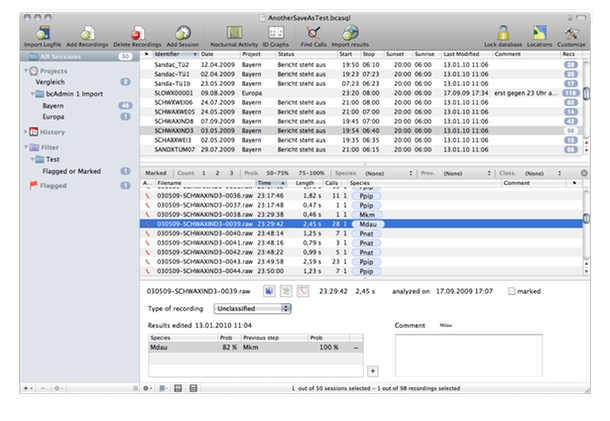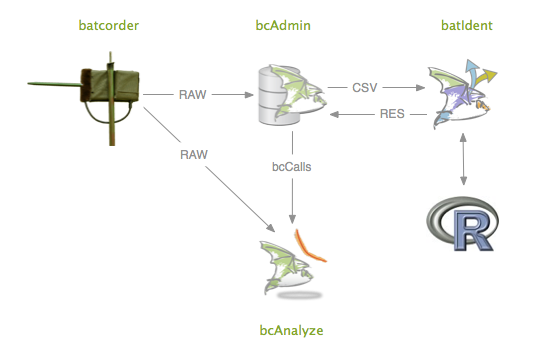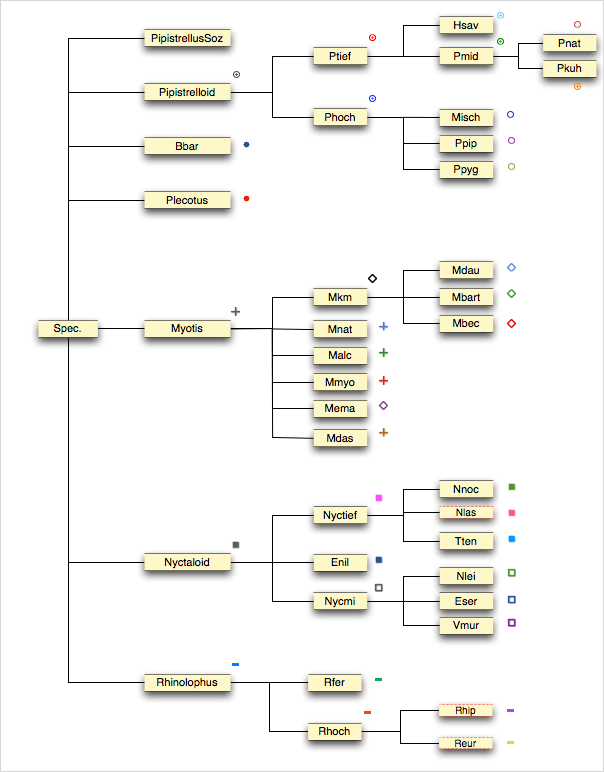To find out how the Batcorder System works, watch the 6 minute demonstration video. This video will revolutionise your bat work! CLICK HERE TO WATCH THE VIDEO
The Batcorder and associated software is the most advanced bat detection and identification system available. Fast becoming the most popular choice in continental Europe, the Batcorder is set to revolutionise your bat work. Read on for a brief introduction to the Batcorder system and how it could benefit you.
Step 1. Batcorder – advanced data recorder
 The Batcorder is the most advanced sound recorder available; such a high quality recording is essential for later analysis using the automatic recognition software. It records bat calls in real-time, whilst excluding other sounds such as crickets, rustling leaves, etc. Simply leave the Batcorder out in the field (battery life is 8 to 10 nights) and it will make high quality recordings (500kHz / 16 bit) of every bat call. Calls are recorded on an SDHC card (up to 32GB). The Batcorder is waterproof and fully programmable. Most importantly, the Batcorder features an omnidirectional microphone mounted on an extender. This eliminates reflection from the main body of the device whilst maintaining 360 degree coverage. The slim microphone tip minimises distortion, which can be a problem with other detectors that have wider microphone membranes.
The Batcorder is the most advanced sound recorder available; such a high quality recording is essential for later analysis using the automatic recognition software. It records bat calls in real-time, whilst excluding other sounds such as crickets, rustling leaves, etc. Simply leave the Batcorder out in the field (battery life is 8 to 10 nights) and it will make high quality recordings (500kHz / 16 bit) of every bat call. Calls are recorded on an SDHC card (up to 32GB). The Batcorder is waterproof and fully programmable. Most importantly, the Batcorder features an omnidirectional microphone mounted on an extender. This eliminates reflection from the main body of the device whilst maintaining 360 degree coverage. The slim microphone tip minimises distortion, which can be a problem with other detectors that have wider microphone membranes.
Step 2. bcAdmin – call management software
 Once you’ve got your recordings, bcAdmin provides an intuitive software package to manage the data. Individual calls are stored in connection with location, call length, time and other information. Search functions exist to aid in finding individual calls. Most importantly, bcAdmin automatically prepares the data for analysis using batIdent. Once the analysis is complete, bcAdmin can present the data in a variety of forms to provide instant graphical representation of bat activity.
Once you’ve got your recordings, bcAdmin provides an intuitive software package to manage the data. Individual calls are stored in connection with location, call length, time and other information. Search functions exist to aid in finding individual calls. Most importantly, bcAdmin automatically prepares the data for analysis using batIdent. Once the analysis is complete, bcAdmin can present the data in a variety of forms to provide instant graphical representation of bat activity.
Step 3. batIdent – free analysis software
At a click of the button, bcAdmin will import bat calls into batIdent, the freely available call analysis software. batIdent has a call library of 77,000 bat calls (and counting!) which can be used to identify 27 species from 11 genera (with some species only to genus). Utilising the freely available statistical package R, batIdent performs single call analysis in a multi step process. Illustrated below is the decision tree which it uses to identify bats. The tree also shows which bats can be identified by batIdent to species and which bats to genus. Currently the call library covers all mid and northern European species and most Mediterranean species. During a typical analysis, batIdent will identify 85% of the calls recorded. The remaining 15% will be excluded as the recording is of insufficient quality or duration to make a positive identification. Up to three species can be identified in any one recording and a percentage probability is provided for each species identification.
Step 4. bcAnalyse – manual analysis software
 For those wanting to perform additional manual analysis on calls, the additional software package bcAnalyse is also available. bcAnalyse lets you view the oszillogram, spectrum and sonogram of the sound file. The user friendly design means you can quickly browse calls and select sound to be transformed into a sonogram or spectral display. bcAnalyse allows you to manually confirm batIdent results or analyse recordings made using other systems.
For those wanting to perform additional manual analysis on calls, the additional software package bcAnalyse is also available. bcAnalyse lets you view the oszillogram, spectrum and sonogram of the sound file. The user friendly design means you can quickly browse calls and select sound to be transformed into a sonogram or spectral display. bcAnalyse allows you to manually confirm batIdent results or analyse recordings made using other systems.
Step 5. Economies of Scale
The Batcorder system scales effortlessly for large projects. Each microphone is supplied with a correction factor, so recordings from different Batcorders can be directly compared. Check out the Wind Turbine Extension to find out how the Batcorder can be deployed for wind farm studies. bcAdmin and batIdent eliminate the time taken for lengthy call analysis. Both the Batcorder and software packages have a proven track record and are on their second or third versions following improvements from earlier versions.

Click on the relevant link for more information on the Batcorder, Software and Accessories.

